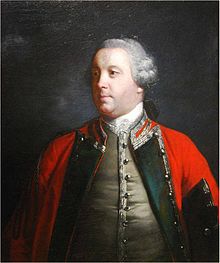Edward Cornwallis, 5th Earl Cornwallis
|
Lieutenant-General Edward Cornwallis |
|
|---|---|

Edward Cornwallis by Joshua Reynolds (1756)
|
|
| Governor of Nova Scotia | |
|
In office 1749–1752 |
|
| Monarch | George II |
| Preceded by | Richard Philipps |
| Succeeded by | Peregrine Hopson |
| Governor of Gibraltar | |
|
In office 14 June 1761 – January 1, 1776 |
|
| Monarch | George II |
| Preceded by | Earl of Home |
| Succeeded by | Baron Heathfield |
| Personal details | |
| Born | 5 March 1713 London, England |
| Died | 14 January 1776 (aged 62) Gibraltar |
| Resting place | Culford |
| Spouse(s) | Mary Townshend |
| Relations |
Charles Cornwallis, 3rd Baron Cornwallis (grandfather) Charles Cornwallis, 1st Marquess Cornwallis (nephew) James Cornwallis, 4th Earl Cornwallis (nephew) William Cornwallis (nephew) Frederick Cornwallis (brother) Stephen Cornwallis (brother) |
| Children | Charles, Charlotte |
| Father | Charles Cornwallis, 4th Baron Cornwallis |
| Military service | |
| Allegiance |
|
| Service/branch | British Army |
| Years of service | 1730s–1776 |
| Rank | Lieutenant General |
| Unit | 8th Foot |
| Commands | 20th Foot, 40th Foot, 24th Foot |
| Battles/wars |
War of the Austrian Succession Father Le Loutre's War Seven Years' War |
Lieutenant General Edward Cornwallis (5 March 1713 – 14 January 1776) was a British military officer who was a member of the aristocratic Cornwallis family. Cornwallis fought in Scotland, putting down the Jacobite rebellion and then was given the task of establishing Halifax, Nova Scotia as the Governor of Nova Scotia (1749-1752). The establishment of Halifax was violently opposed by the indigenous Mi'kmaq and Cornwallis attempted to stop the attacks by first attempting to banish them from peninsular Nova Scotia. The proclamation included a bounty to "take prisoner or scalp" Mi'kmaw fighters. A bounty was later offered for Mi'kmaw women and children to be taken prisoners. Cornwallis negotiated the ill-fated Treaty of 1752 with one band of Mi'kmaq, but was unsuccessful in defeating the Mi'kmaq. Cornwallis thought of the Mi'kmaq as British subjects and, therefore, considered them to be rebels. Cornwallis returned to London, where he was elected as MP for Westminster and married the niece of Great Britain's first Prime Minister. Cornwallis was then given the position of Governor of Gibraltar.
Cornwallis is remembered in the naming of rivers, parks, streets, towns and buildings in Nova Scotia. The honouring of Cornwallis has become controversial in Nova Scotia, where some Mi'kmaq and others object. A statue of Cornwallis in a downtown park in Halifax has been the site of protests and vandalism.
He was the sixth son of Charles, 4th Baron Cornwallis, and Lady Charlotte Butler, daughter of the Earl of Arran. The Cornwallis family possessed estates at Culford in Suffolk and the Channel Islands. His grandfather, Charles Cornwallis, 3rd Baron Cornwallis, was First Lord of the Admiralty. His nephews were Charles Cornwallis, 1st Marquess Cornwallis, James Cornwallis, 4th Earl Cornwallis, and William Cornwallis.
...
Wikipedia
